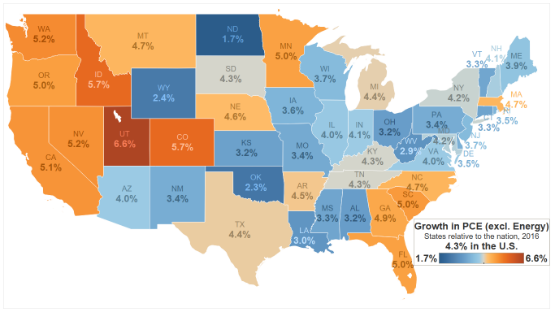A State-Level View of 2017 Consumption Patterns
05 Mar. 2018 | Comments (0)
Every month, the Bureau of Economic Analysis (BEA) updates estimates of personal consumption expenditures (PCE) for the nation. At the state level, however, the BEA provides only annual updates with a substantial delay—the 2017 update is scheduled to come out on October 4th, 2018. The Conference Board has tried to fill this gap by nowcasting nominal PCE growth by state, providing estimates for 2017. In this blog we explain how we have set up the model and share our thoughts on the main consumption patterns across states.
Prior to the official release of BEA updates, our model can provide reliable nowcasts about consumption growth by state. To increase accuracy, we estimate PCE excluding energy consumption, since volatile oil prices exert a large effect on energy prices and mask real consumer trends. We also used a list of economic indicators related to consumer spending and early testing suggests our model would have performed well in past years.
In table 1, all model input variables are listed. By definition, the national PCE is an aggregate of all states, and so it functions as the most important input and guides our 2017 projections by state. To capture variations in state-level conditions, indicators for total income, population, employment, house prices, and residential permits are included. Though we exclude energy consumption from PCE, gasoline prices are also added as they influence the remaining disposable income after gasoline purchases. In addition, oil prices are assumed to affect consumption differently in oil producing states because in these states, higher oil prices boost incomes for some workers and therefore consumption of other goods.
Table 1: Indicators used to estimate nominal Personal Consumption Expenditures (excluding energy consumption) growth by state.

In 2017, national PCE excluding energy consumption grew by 4.3 percent, continuing a strong growth trend that started in 2014. Most states stayed close to this trend, as shown in Chart 1. It appears most states performed generally well, with Western and South Atlantic states showing especially strong growth. The three fastest growing states are respectively Nevada, Utah, and Idaho. On the other hand, Connecticut, Oklahoma, and West Virginia were the weakest performers. Chart 2 displays the actual BEA estimates for 2016.
Looking at the state nowcasts more broadly, two trends stand out. First, the long-run trend of consumption activity shifting from the Northeast and Midwest to the South Atlantic and the West appears to have continued in 2017. Second, with the recovery in oil prices and production in 2017, oil states bounced back. Oil states were among the fastest growing states prior to 2015, but they experienced a heavy setback in 2015 and 2016 as oil prices dropped. North Dakota is estimated to move from 1.7 percent in 2016 to 4.6 percent 2017, Oklahoma increasing from 2.3 to 3.5 percent, and Wyoming rising from 2.4 to 3.7 percent. Texas, which has a larger and more diversified economy than other oil states, did not drop as much in 2015 and 2016, but also benefited from increased oil prices.
Chart 1: 2017 showed generally strong performance, but West and South Atlantic states grew visibly faster.
Nominal PCE growth, from 2016 to 2017, relative to the national, estimated from model.

Source: The Conference Board.
Chart 2: 2016 was a weak year for oil states.
Nominal PCE growth, from 2015 to 2016, relative to the national.

Source: U.S. Bureau of Economic Analysis.
-
About the Author:Frank Steemers
The following is a bio or a former employee/consultant Frank Steemers is a Senior Economist at The Conference Board where he analyzes labor markets in the US and other mature economies. Based in New …
-
About the Author:Gad Levanon, PhD
The following is a biography of former employee/consultant Gad Levanon is the former Vice President, Labor Markets, and founder of the Labor Market Institute. He led the Help Wanted OnLine©…
-
About the Author:Brian Schaitkin
The following is a biography of former employee/consultant Brian Schaitkin is a former Senior Economist in U.S. Economic Outlook & Labor Markets at The Conference Board. He is part of a team work…




0 Comment Comment Policy